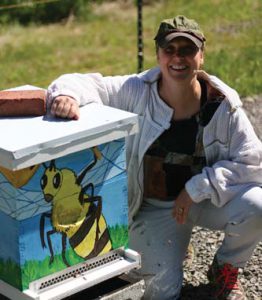Euthanasia
Dr. Tracy Farone
Euthanasia: Our Bees Deserve the Consideration
One part of my job as a veterinarian has been to provide euthanasia services. It is not an easy part of our job, but it is a part of my veterinary oath to “relieve suffering”. It is a service I am glad that I can provide to clients’ animals when deemed necessary. Over the years, I have received many thank you cards, flowers, and other gifts from appreciative people who trusted me to guide the passing of their beloved animal. It is time we consider euthanasia and how it may be applied to our honey bees.
I am sure some of you have had to face the difficult situation of making the decision to terminate a hive. In the field of apiculture, standard methodology for honey bee euthanasia is still in its early stages, but I will outline the major caveats here.
The Definition of Euthanasia
The term euthanasia means “good death”. According to the American Veterinary Medical Association (AVMA), “The term is usually used to describe ending the life of an individual animal in a way that minimizes or eliminates pain and distress. A good death is tantamount to the humane termination of an animal’s life.”(1) Periodically, the AVMA publishes guidelines that outline acceptable methods of euthanasia that veterinarians should use specifically and for a wide variety of animals. This 100+ page document contains some verbiage on invertebrate euthanasia, but a section specific to honey bees does not yet exist.
The AVMA says the following regarding invertebrate species (which would include honey bees), “While there is ongoing debate about invertebrates’ abilities to perceive pain or otherwise experience compromised welfare, the Guidelines assume that a conservative and humane approach to the care of any creature is warranted and expected by society. Consequently, euthanasia methods should be used that minimize the potential for pain or distress.” (1) The AVMA also recommends that each euthanasia technique for any animal consider the following criteria:
“1. ability to induce loss of consciousness and death with a minimum of pain and distress
2. time required to induce loss of consciousness
3. reliability
4. safety of personnel
5. irreversibility
6. compatibility with intended animal use and purpose
7. documented emotional effect on observers or operators
8. compatibility with subsequent evaluation, examination, or use of tissue
9. drug availability and human abuse potential
10. compatibility with species, age, and health status
11. ability to maintain equipment in proper working order
12. safety for predators or scavengers should the animal’s remains be consumed
13. legal requirements, and
14. environmental impacts of the method or disposition of the animal’s remains.” (1)

A few of the criteria above may not apply to honey bee colonies, but most do and could serve as a checklist for beekeepers and veterinarians to consider before euthanizing a honey bee colony.
How Veterinarians Use Euthanasia
In traditional veterinary practice, most veterinarians will agree to euthanize an animal for one of two major reasons: 1. A serious or terminal condition or illness that causes the animal suffering that cannot be reasonably remedied, or 2. An aggressive animal that poses a threat to people and/or the public. This is much the same for honey bee colonies.
Why We Euthanize Honey Bee Colonies
Typically, we consider euthanizing hives when they are severely ill, severely aggressive, and/or pose a public health threat. For example, in most states, hives diagnosed with American Foulbrood must be destroyed or it is highly recommended that they are destroyed, because they are most likely terminally ill themselves and can spread the disease to other hives. Severely aggressive hives may also be considered for euthanasia as they may pose a public health threat and may transfer aggressive genetic traits to future bee generations.
“Weak” hives may be a bit of a different story and a somewhat unique situation to honey bees. If the disease or condition in a “weak hive” is not severe or highly transmissible, we may be able to save a portion of a colonies’ bees by combining colonies and/or requeening. “Pinching” (and replacing) a failing queen may be a physical method of euthanasia for her and her genetics, but the colony may persist.
Some Current Methods
There are several methods “out there” used for destroying a colony. I will briefly go through each method and point out their pros and cons. When euthanizing a colony be sure to have all your supplies ready before you start the process. It is best to start the process at dusk so all the bees are present in the hive and few may escape the colony. Also close all the entrances to prevent escape as much as possible.
If you must burn the hive and colony after the euthanasia, make sure you are legally allowed to do so and you are following all local and state laws. If you must bury the burned hive remains, be sure to dig a pit big enough to accommodate the hive boxes. Typically, this is at least 18 inches in depth. Don’t forget to call 811 first. Then build a fire in the pit, so it is ready to receive the euthanized hive, if burning is necessary. Remember beeswax is flammable.
1. Soapy water and/or vinegar/water solutions: These methods are fairly safe for beekeepers, but it does require opening the top of the hive to dump or spray the solution directly onto the bees through the frames. This may not be ideal for aggressive hives. It may also not kill all the bees quickly, especially if enough solution is not applied. Various mixtures have been used: ¼ dishwashing liquid to ¾ water, half and half water and vinegar with added soap, all with enough solution to soak the frames. If you must burn a hive euthanized by these methods, consider that a very wet hive may not burn as well. If you do not need to burn the hive and/or infectious disease was not the issue, the hive equipment can be cleaned and reused. Comb and honey should be discarded. The USDA mentions soapy water as a method of euthanasia for bees.
2. Isopropyl alcohol solution: If you have ever done an alcohol wash to check for mites, you will have noticed that alcohol kills bees quickly. For this reason, this method may be more humane for the bees. However, consider that isopropyl alcohol is flammable. You can dilute 70% isopropyl alcohol with water at least to a half and half solution. I have seen some claim that as low as a 5% solution will work, but I have not verified that myself. If you do not need to burn the hive and/or infectious disease was not the issue, the hive equipment can be cleaned, dried, and reused. Honey and comb should be discarded.
3. Fire: Again, if you are destroying a hive for AFB, fire is the preferred method. Dig the burning pit as close to the hive as possible to avoid moving the hive and possibly spreading spores. Be sure all entrances are closed. It is best to euthanize the bees first before burning the hive.
4. Professional chemical sprays: While utilizing pesticides is not generally recommended for killing honey bees and it will contaminate the environment and the hive equipment, if you are dealing with a particularly aggressive hive or a feral colony that has invaded a building structure, it may be time to recruit some professional extermination help. Always remember to consider your safety and the safety of those around you first.
5. Other methods that are dangerous, impractical, and/or inefficient, and therefore not recommended: Gases (CO2, ethylene oxide). Flammables like oil, kerosene, or gasoline…just, please, no. Irradiation is rarely practical and can be costly.
The Best Ends
Because of the unique nature of our honey bees, they can present a challenge in performing a proper euthanasia. However, I believe we should take time to consider how we should best approach the situation and look to develop better methods of accomplishing a “good death” for our bees. More work should be done on this topic and it would be a good opportunity for beekeepers and veterinarians to partner in coming up with better solutions. We should also take time to acknowledge and be empathetic to the emotional toll it may take on us, as beekeepers.
References & Resources:
https://www.avma.org/sites/default/files/2020-01/2020-Euthanasia-Final-1-17-20.pdf Accessed 09/09/2021.
Kane, Terry R. and Faux, Cynthia M, ed. Honey Bee Medicine: For The Veterinary Practitioner. Wiley Blackwell. 2021. pp.356.
Honey Bee Veterinary Consortium – How to Euthanize a Hive. https://www.hbvc.org/content.aspx?page_id=274&club_id=213546 Accessed 09/09/2021.











